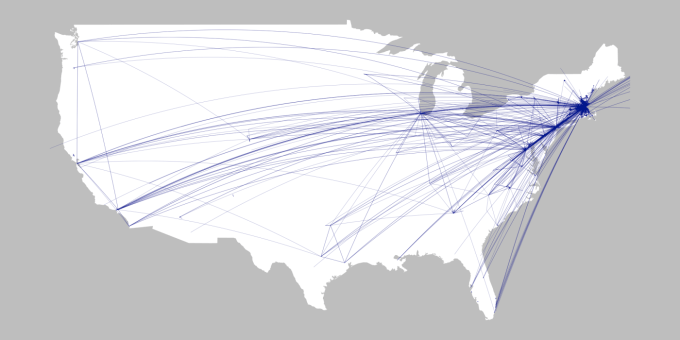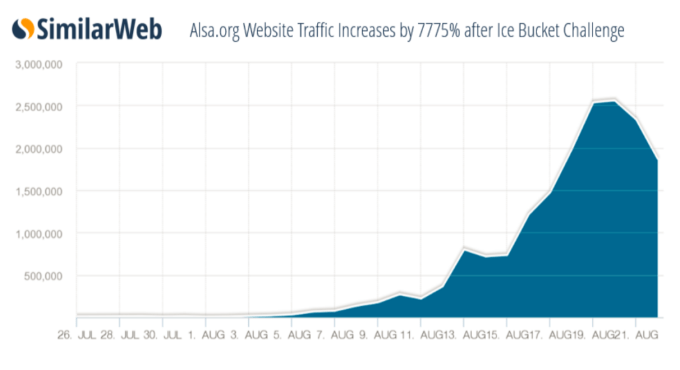-
Lucas Monteiro Bianchi wrote a new post on the site Lucas Monteiro Bianchi 10 years, 2 months ago
Posted Sep 3, 2014 by Sarah Perez (@sarahintampa)

The ALS Ice Bucket Challenge has shown that other things besides Grumpy Cats and silly dance videos can go viral – even charitable giving. And while some questioned if having people dumping buckets of ice on their heads was the best way to raise money for the non-profit organization fighting Lou Gehrig’s disease, it turns out those concerns were unfounded: ALSA.org reports that as of September 2, it has received $106 million in Ice Bucket donations from over 3 million donors.
Donations have ranged from under $1 to $200,000, the organization reports, and have come from individuals, corporations and other foundations. Individuals who donated between $100,000 and $200,000 have included actors Leonardo DiCaprio and David Spade, T-Mobile CEO John Legere and Chairman of Carnival Cruise Lines Micky Arison.
The spotlight has brought a heightened awareness about the disease and related research efforts, but it has also put ALSA under attack to some extent, forcing it to defend itself againstclaims from satire websites that people share on social media as if they’re hard news. (This is why Facebook has been testing the use of a “satire” tag on shared news stories – Facebook users apparently have difficulty discerning truth from bias and falsehoods.)

While the challenge’s success as a viral meme should be the feel-good story of a year filled with bad news involving wars and violence and terrorism, some in the media have poured cold water (ha!) on the positive, warm-and-fuzzy feelings this viral act of charity has inspired.Quartz pointed out, for example, that the ALSA is sucking in donations at the expense of other charities, who will now suffer. Vice said the challenge is “narcissism masked as altruism,” which BBC countered by saying that might not be such a bad thing.
The Meme’s Spread
The Ice Bucket Challenge has proven to be an interesting study into the spread of viral memes, as well. Earlier in August, Facebook’s data scientists looked at data from June 1 through August 17, and visualized the challenge’s spread across the U.S.
The spread structure was centered in Boston, which Facebook speculates could be attributed to former Boston College baseball player, Pete Frates, who was diagnosed with ALS in 2012.


This is a notable data point, since the challenge’s origins are actually somewhat unclear, and have been attributed to a number of sources, including a “cold water challenge” that began in the Northern U.S., which is documented in more detail on KnowYourMeme.com. The original version involved jumping into cold water, then nominating another to do the same. Later, this became the ice bucket dump, and charitable donations were the result of refusing to participate.
By late July 2014, however, the charity being named was the ALS Foundation.
The challenge spread worldwide on Facebook to the following countries (in order of participation): Australia, New Zealand, Canada, Mexico, Brazil, Germany, Philippines, Puerto Rico and India.
During that time frame, over 28 million people joined the challenge by posting, commenting or liking a challenge post, Facebook said.
Meanwhile, Facebook’s video platform was heavily utilized for sharing the actual ice bucket challenge videos. Facebook says 2.4 million videos were shared on the network during those dates.

Celebrities, singers and musicians, sports figures, TV shows’ cast and crews, CEOs and other business leaders, have since participated, allowing the ALS Challenge to spread even further. We’ve covered some of these videos here at TechCrunch, as related to tech executives, including challenge videos from Bill Gates, Tim Cook, Apple SVP Phil Schiller, Mark Zuckerberg, Sheryl Sandberg, Satya Nadella, Larry Page and Sergey Brin, Jeff Bezos, Philip Kaplan (@pud), Ev Williams, Kevin Rose, and Bryan Mason, and more.
According to data curated by media analyst Jeremiah Owyang, near the end of August, the challenge had then been responsible for around 2,330,000 YouTube videos and was responsible for more Google searches than Gaza, Ferguson, and Iraq combined. (See below slideshow). That latter statistic may seem depressing, but the fact that the Challenge emerged amid an otherwise horrific news cycle could have actually helped contribute to its success. People needed a bright spot to cling to.
Data from video analytics company Strike Social shared at the end of August, notes that Charlie Sheen’s Ice Bucket Challenge video had by then just narrowly beaten out Bill Gates’ video in terms of views, with 16,743,369 views on the TMZ YouTube channel versus 16,031,256 views on Gates’ thegatesnotes channel. Others near the top of the list included Cristiano Ronaldo, the “fails” compilation (people whose challenge videos went horribly wrong), Kermit the Frog’s challenge video, and those from other celebs.
Web analytics firm SimilarWeb also looked into the top five celebrity videos on YouTube, ranked in order of their search engine popularity for driving traffic to YouTube and found that Charlie Sheen again beat out Bill Gates on this metric as well, followed by Chris Pratt, Lady Gaga, and Kate Upton.
Of course, the video numbers are ever-changing as new viewers stumble across the challenge videos and Facebook posts every day.
Affect On ALSA.org and Other Website Traffic
While much of the data about the challenge so far has focused on the number of videos and increasing size of the donations, SimilarWeb also took a look at how the viral sensation also affected the ALSA.org website itself, along with other organizations. The company tracked data from over 30 million websites with 1.1 trillion visits for the months of July and August 2014, to arrive at its conclusions.
Before the Ice Bucket Challenge, the website was averaging close to 8,000 visitors per day. Over the last 4 weeks, that changed dramatically, with the average number of visitors rising to 630,000 per day, or an increase of 7,775%.

During the month of July, 11% of visitors clicked on the donate button to go make donations, and by August 24th, the organization shared that it had already raised $70.2 million from 1.3 million donations, compared with $2.5 million raised during the same time (July 29-Aug. 24) the year before.
This data tracks against the 10.3 million visitors to the ALSA.org website during the period SimilarWeb measured, resulting in 10% of web visits converting into real money donations, the firm reports.
Additionally, news sites covering the challenge have benefitted too, SimilarWeb notes, with ALS as the #7 trending news keyword referringtraffic to CBS News, for example, and the #4 top traffic keyword referring traffic to Forbes.com, which is averaging over 200,000 visits per week on ALS and Ice Bucket Challenge search terms.
The Challenge even impacted Wikipedia, resulting in a more than 100 times rise in pageviews for ALS, which speaks to its capacity for awareness-raising.
Slacktivism Can Raise Real Money
The challenge has not been without its critics, of course. In addition to the above-mentioned claims of how it could hurt other charities, or how it contributes to a generation’s self-indulgence, others have said the challenge is an example of “slacktivism,” meaning a sort of stunt philanthropic gesture that won’t lead to an ongoing relationship between the charity and donor.
That may be true, but with over $100 million raised thanks to the challenge, the ALSA should be doing okay for at least a little while. And when they use these funds up, maybe the world will be ready for Ice Bucket, take 2.
At the end of the day, the Ice Bucket Challenge was successful because it took a simple formula for viral content creation, and added the charitable request as part of its easily reproducible format.
TechCrunch examined this “symbiotic meme” structure before, following the Harlem Shake’s rise as a viral sensation. The idea, simply put, is to create a short video where users can insert their own variables into the equation, and replicate the action with little video production skill. Pouring an ice bucket over one’s head – or having a friend do it – is easy to mimic.
The Ice Bucket Challenge’s legacy is that it could become a blueprint for achieving viral success, which other charities could choose to replicate. Simply ask the selfie generation to once again turn their cameras on themselves, but infuse that act with a higher purpose.
SOURCE: http://techcrunch.com/2014/09/03/the-ice-bucket-challenge-by-the-numbers/ -
Lucas Monteiro Bianchi wrote a new post on the site Lucas Monteiro Bianchi 10 years, 3 months ago

On a daily basis, my inbox is flooded with emails. There is so much information to be processed and so much data to look at that it can at times feel overwhelming. I’d wager this phenomenon is not one I’m facing alone.
Every day, marketers are getting more and more information about what their customers are doing. As a result,customer analytics and predictive analytics have become increasingly important. You’re collecting data from digital marketing, social media, call centers, mobile apps, and more. But how do you take that data and make it actionable? How do you use the information on what your customers have done in the past to gauge what they may do in the future? The answer to these questions is simple: you use statistics.
Previously, I talked about customer analytics and its importance to your business. Predictive analytics is a huge piece of the customer analytics puzzle. Understanding what our customers are likely to do is at least as important as what they have done or purchased in the past. To have a truly robust understanding of your clients and their needs, predictive analytics needs to be part of your toolset.
Predictive analytics has many business applications. Ultimately, this science helps you understand what your customers are likely to do based on what they’ve done in the past. Many companies shy away from this science because it seems like such an overwhelming concept. Isn’t using statistics to predict behavior terribly futuristic? Not as much as you’d think. Predictive analytics is something you likely encounter every day.
For instance, your credit score is calculated using predictive analytics. Based on a set of data points regarding your payment history, loan applications, employment history, and more, financial institutions calculate your credit worthiness. In their eyes, your credit score is a predictive indicator that uses statistics to determine how likely you are to repay a loan. This science has been used for years. That said, predictive analytics is growing in both popularity and accuracy. Plus, new tools on the market make it much more accessible to the average business.
Still, it can be tough to understand what goes into the calculations behind this science. Predictive analytics would be nothing without statistics—a word many find daunting. Not to fear. Statistics can be easily accessible and interesting when explained well. In fact, my colleague John Bates can even use statistics to explain why there is a correlation between poison and knitting. How much more fun could science be?
You may be asking yourself how this could possibly be fun. In fact, you could even be asking yourself what a correlation is. Don’t worry. I’ll make this fun by giving you a job we’ve all always wanted. Imagine you are a detective. Your job is to solve a mystery. This mystery may be something as pertinent to your business as finding out whether mobile app users are more loyal. To solve that mystery, you’ve got a set of data points (which is kind of what facts and clues really are anyway).
The set of data points we’re going to look at encompasses all the facts you have as a detective. These facts can include information about Web behaviors, mobile interactions, call center experience, point of sale information, social media activity, and more. This set of data points is what organizations refer to as Big Data.
The problem for most detectives is that Big Data is just what it sounds like: it’s a ton of data. A huge data set can be incredibly hard to sift through and understand. In fact, Deloitte published an article earlier this year stating that in a survey of 100 CIOs, Big Data was expected to be one of the biggest technological disruptors of 2013. Most companies simply don’t know how to handle the volumes of data they now have access to. So how are you going to sort through that and solve your mystery in a fashion that won’t take years? That’s right: statistics! Using statistics to power predictive analytics will make your detective work successful.
A great example of this is The General Automobile Insurance Services. By analyzing its Web traffic, this enterprise found that users tended to stop the application process when they landed on a page requesting their VIN number. The General used this information to create a program that prepopulates the VIN number based on other information, resulting in an increase in conversions. They used statistic and customer data to predict how a change in their interface could increase customer satisfaction and sales.
Still not sure you need statistics and predictive analytics? Consider it this way: statistics let you determine the relationship between certain data points. Without this, you’re making educated guesses at best. Statistics works like a lever, allowing you to work with much larger data sets than you normally could manage the same way a lever allows you to lift much heavier loads than you, as a mere mortal, would normally be able.
If you’re not utilizing Big Data, statistics, and predictive analytics, you can’t get to the bottom of your business questions, create effective strategies, or accurately market to your customers.
If you’re looking to learn more on predictive analytics or statistics, check out this great predictive analytics reading list at Forrester.
By Chris Wareham on December 18, 2013SOURCE: http://blogs.adobe.com/digitalmarketing/analytics/why-predictive-analytics-is-important-for-your-customer-analytics-strategy/
-
Lucas Monteiro Bianchi wrote a new post on the site Lucas Monteiro Bianchi 10 years, 3 months ago

Statistics are sets of mathematical equations that are used to analyze what is happening in the world around us. You’ve heard that today we live in the Information Age where we understand a great deal about the world around us. Much of this information was determined mathematically by using statistics. When used correctly, statistics tell us any trends in what happened in the past and can be useful in predicting what may happen in the future.
Let’s look at some examples of how statistics shape your life when you don’t even know it.1. Weather Forecasts
Do you watch the weather forecast sometime during the day? How do you use that information? Have you ever heard the forecaster talk about weather models? These computer models are built using statistics that compare prior weather conditions with current weather to predict future weather.2. Emergency Preparedness
What happens if the forecast indicates that a hurricane is imminent or that tornadoes are likely to occur? Emergency management agencies move into high gear to be ready to rescue people. Emergency teams rely on statistics to tell them when danger may occur.3. Predicting Disease
Lots of times on the news reports, statistics about a disease are reported. If the reporter simply reports the number of people who either have the disease or who have died from it, it’s an interesting fact but it might not mean much to your life. But when statistics become involved, you have a better idea of how that disease may affect you.
For example, studies have shown that 85 to 95 percent of lung cancers are smoking related. The statistic should tell you that almost all lung cancers are related to smoking and that if you want to have a good chance of avoiding lung cancer, you shouldn’t smoke.4. Medical Studies
Scientists must show a statistically valid rate of effectiveness before any drug can be prescribed. Statistics are behind every medical study you hear about.5. Genetics
Many people are afflicted with diseases that come from their genetic make-up and these diseases can potentially be passed on to their children. Statistics are critical in determining the chances of a new baby being affected by the disease.6. Political Campaigns
Whenever there’s an election, the news organizations consult their models when they try to predict who the winner is. Candidates consult voter polls to determine where and how they campaign. Statistics play a part in who your elected government officials will be7. Insurance
You know that in order to drive your car you are required by law to have car insurance. If you have a mortgage on your house, you must have it insured as well. The rate that an insurance company charges you is based upon statistics from all drivers or homeowners in your area.8. Consumer Goods
Wal-Mart, a worldwide leading retailer, keeps track of everything they sell and use statistics to calculate what to ship to each store and when. From analyzing their vast store of information, for example, Wal-Mart decided that people buy strawberry Pop Tarts when a hurricane is predicted in Florida! So they ship this product to Florida stores based upon the weather forecast.9. Quality Testing
Companies make thousands of products every day and each company must make sure that a good quality item is sold. But a company can’t test each and every item that they ship to you, the consumer. So the company uses statistics to test just a few, called a sample, of what they make. If the sample passes quality tests, then the company assumes that all the items made in the group, called a batch, are good.10. Stock Market
Another topic that you hear a lot about in the news is the stock market. Stock analysts also use statistical computer models to forecast what is happening in the economy.
Source: http://www.mathworksheetscenter.com/mathtips/statsareimportant.html -
Lucas Monteiro Bianchi wrote a new post on the site Lucas Monteiro Bianchi 10 years, 3 months ago

July 23, 2014 6:00 AM Michael Howard, C9 Inc. Sales forecasts are often one part guesswork, one part analysis, and three parts wishful thinking.
And yet, sales forecasts are critical business tools used to make big decisions on everything from hiring to budgets to expansion plans. Basing pivotal business decisions on a wish-cast is insanity — yet companies do it every day. NASDAQ and NYSE are littered with stock dives from “surprising” revenue results. Even the most respected companies in the Fortune 20 sometimes get their forecasts dead wrong.
As New Yorker journalist James Surowiecki points out, experts in any given field “are prone to making daring and confident forecasts, even at the risk of being wrong, because when they’re right the rewards are immense.” But when you’re wrong about a sales forecast and then use that “data” to make critical business decisions, the results can be disastrous.
There is a better way: Use software to move sales forecasting out of the land of wishful thinking and into the measured, metrics-driven world of big data. Sales forecasting algorithms can serve as a pair of unbiased eyes analyzing every aspect of your forecast — like a business consultant, but without the fees, ramp time, and 30 slides of endless abstraction. Algorithms can score your numbers, leads, and opportunities and compare them to petabytes of industry sales data to make the “call” on a forecast.NOTE: VentureBeat’s upcoming GrowthBeat event — August 5-6 in San Francisco — is exploring the data, apps, and science of successful marketing. Get the scoop here, and grab your tickets now to save $200!
Software-driven sales forecasting facilitates a new type of culture within a company, one where action, facts, and clarity become the tenets of your business, instead of wishful thinking.
Here are three reasons your sales department needs to embrace data science now.Reason No. 1: Improve clarity in sales communications
Sales people speak a different language — and few outside of sales seem to understand what they’re talking about. Other teams in the office often struggle to interpret what sales people say into actionable strategies to improve business outcomes.
Case in point: “It will close tomorrow” could mean “the deal will close tomorrow” or “it will probably never close.” This is why a vice president of sales hires “his” guys because he trusts them, understands them, knows their language, and can translate their language back into the C-suite.
A data-driven approach, using methods like opportunity scoring and forecasts generated by machine learning, takes sales out of the realm of sales-speak and into the land of measurable, metrics-driven business culture. A high, medium, or low score is a something everyone in the office can understand and use to make the right business decisions in their departments.Reason No. 2: Reduce complexity in forecasting
Algorithms don’t try to think outside the box. They just crunch data and spit out numbers. But sales managers often do try to think outside the box when making forecasts. They are human, so they usually consider too much or not the right kind of information when making predictions and thus come to non-valid conclusions. Complexity more often than not reduces validity.
Several studies (described in Daniel Kahneman’s book “Thinking Fast and Slow”) have shown humans will make inaccurate predictions even when told what the correct outcome is before making a decision. They feel they can overrule a proven finding by analyzing additional information about a case, but this additional research is actually anecdotal, not empirical, and does nothing to change the final outcome.Reason No. 3: Rein in inconsistency
Not only does over-analysis and complex thinking get in the way of creating accurate sales forecasts; so, too, does inconsistency. People, unlike computers, are inconsistent. Their thoughts, feelings, and judgments change all the time in response to internal and external circumstances.
Companies depend on people to come up with accurate sales forecasts, but people are by nature inconsistent in how they approach data collection and analysis. One day a sales rep may be feeling excited and happy and will look at data and see a wildly positive forecast. The next day, feeling negative or tired, he may see an entirely different nuance. (Sales forecasts can even change depending on the time of day they’re created; fueled up on coffee, sales reps tend to create more positive forecasts in the morning, compared to more metered forecasts in the afternoon.)
Algorithms don’t have feelings, so they approach data analysis and forecasting with complete consistency. When you’re looking for an accurate sales forecast, a computer will always deliver the more reliable report over its human counterpart.
Of course, until now, applying data science to sales forecasting didn’t make much sense, because companies didn’t have the data, expertise, or software needed to infuse data science into the sales cycle, namely into weekly pipeline or forecast meetings. On top of that, there was a lack of will and, to a certain extent, fear and disdain toward using software to forecast sales. Many professionals still argue sales is an art, not a science.
But the availability of cloud-based sales applications leveraging data science have changed all that. To get accurate sales forecasts, there’s no longer any need to hire high-priced data scientists, no more lengthy processes to gather up company and industry-wide data, and no more questions about how to interpret the results.
Software will never replace the magic a great salesperson brings to closing a deal, but then again, it will never present wish-casts just to make executives happy.
Michael Howard is chief executive of C9 and who brings over 20 years of experience in the analytics industry, including at companies such as Greenplum/EMC, Ingrian Networks, Oracle, Outerbay and Veritas.
Source: http://venturebeat.com/2014/07/23/3-reasons-your-sales-team-needs-data-science/ -
Lucas Monteiro Bianchi wrote a new post on the site Lucas Monteiro Bianchi 10 years, 4 months ago
 Thank you for visiting my page!
Thank you for visiting my page!My name is Lucas Monteiro Bianchi. I am a Statistics student at Federal University of Mato Grosso localizated in Mato Grosso, Brazil. At the present time, I am participating in Brazilian Scientific Mobility Program sponsored by CAPES at Temple University. It is localized in Pennsylvania – PA. The scholarship duration is 1 year and 6 months.
As student, I had a unique experience in the academic research during two years. It was a study about some social characteristics of Brazilian immigrants to Japan and some factors that can influence the time of residence through a social approach and regression models, respectively. To set the data, analyses and plot the results I learned how to use R and Excel (and also, survival analysis on SAS), to show the results, I used programs as PowerPoint and Prezi, and to publish scientific essays I learned LaTeX and Microsoft Word.
I am grateful for your time learning a little about me. I am confident that my efforts will be a great opportunity to make your plans real. I am open to hear about your ideas and projects, please reach me at: lucas.bianchi@temple.edu
-
Lucas Monteiro Bianchi changed their profile picture 10 years, 4 months ago
Connect and innovate with an elite information systems program
Footer
MANAGEMENT INFORMATION SYSTEMS
Fox School of Business
Temple University
210 Speakman Hall
1810 N. 13th Street
Philadelphia, PA 19122
